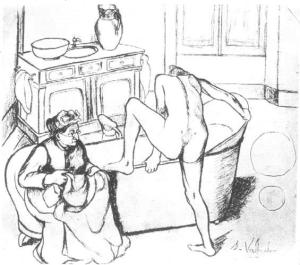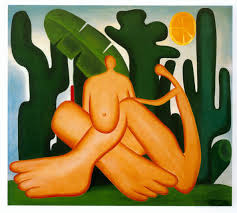Modernism
Modernism is the response to the social and cultural changes
that was occurring during Europe of the 19th century with the
greatest event of the industrial revolution, the introduction of the machine,
wealth and mass production, women’s social position have changed drastically
compared to the middle ages, at the dawn of the 20th century women
gained more rights in terms of work and academia and no longer completely
dependent or confined to maternity, the Guerrilla Girls state “But there was
also more opportunity than ever before for a woman to live her life and make
art on her own terms.”(59). This change affected every aspect of life, and naturally it transformed the art world and the artist, because prior to this, the
artist was either confined to deal with a biblical subject if commissioned by
the church or follow the rules and the taste of the patronage, which were
mostly wealthy families interested in self-portraits, women artist were
acknowledging the male gaze and that was the dominant theme of their work. With
the introduction of art as a product, the cultural and social transformations, artists ventured to experiment with ideas outside the traditional boundaries and a new perception was emerging in relation
between the artist and the work and in the process new forms of art were
introduced during the 19th and 20th. Chadwick explains “During
these same years, artists in England and France were also abandoning naturalism
in favor of stylized abstractions.”(256), abstraction is a composition of
colors, geometric designs and shapes in which the depiction or the art work is not necessarily recognizable
but the infusion is rather intended to conveys a sense, or portray a political situation as Chadwick points out “its course,
inextricably bound up with the formal developments of Post-Impressionism and
Cubism, and with a desire to break with nature and infuse the resulting art
with a profound spiritual content.”(252) during this period women artist given the better circumstances
of the time were at the heart of abstraction both as creators and representatives
of the new visual culture, traditional appearance and the woman dress became
one of the central issues for debate in the feminists movements in particular
and intellectuals in general. The redesign of the old dress into one that is
more practical and flexible led to a new realm in fashion design, a marriage
between art and craft. Some of the prominent figures of this movement were
Margaretha von Brauchitsch, Wassily Kandinsky, Gabriele Munter, Roger Fry, Vanessa
Bell and Sonia Delaunay. According to Chadwick Delaunay made her “first
completely abstract” debut after the birth of her child in 1911, the work was
named Couverture it was influenced by Russian peasant design and Cubism.
Sonia Delaunay
Couverture 1911
Couverture 1911
Wassily Kandinsky
First Abstract watercolor 1910

After world war 1 with the strong presence of industrialization and materialism the Dada movement assumed popularity in Paris, influenced by the prior movements like Expressionism and Cubism. Dada as explained by the Guerrilla Girls is " an art movement that challenged every convention (except male supremacy) and scandalized bourgeois society"(66) essentially the movement was a reaction and an attack on the nationalistic and materialistic tendencies of the middle class. Artists like Jean Arp and his wife, Sophie Taeber-Arp and Hannah Hoch were pioneers of the movement.
The relative advancement of women rights in terms of employment and education overshadowed the polemic subject of the female body, Chadwick points out "Marginalized in the aesthetic and political debates swirling around modern art movements in the early decades of the twentieth century, many woman turned to the female body as the primary subject of a woman's experience."(282) Suzanne Valadon was deeply interested and experimenting with the nude female body, her work is considered a critique to the pervasive concepts of women as controlled by emotions and biology, it was also an attack on the presentation of the female body as "lush surface isolated and controlled by the male gaze"(Chadwick 285) which distinguished her from contemporaries.
Suzanne Valadon
Grandmother and Young Girl Stepping into the Bath 1908

Valadon's work was characterized by domesticity and community and the figures are wholly absorbed in their own action, also she emphasizes the natural gestures during physical execution.
From the Dada movement came Surrealism, which at the begging attracted many women artist, surrealism was similar to dadaism in that it rejected the middle-class condition and highly influenced by the works of Sigmund Freud on the unconscious, Chadwick explains"During the 1930's women artist came to surrealism in large numbers, attracted by the movement's anti-academic stance and by its sanctioning of an art in which personal reality dominates"(310), nevertheless given the nature of the movement and the established role for women in it, they eventually withdrew from the new school.
Kay Sage
In The Third Sleep

Tarsila Do Amaral
Anthropophagy 1929

Modernism transformed the structure, colors and subject of the paintings, it became a window for imagination and a medium to express inner most feelings.
Works Cited:
Chadwick, Whitney. Women, Art, and Society. Fifth Edition. New York: Penguin, 2002. Print.
Guerrilla Girls. The Guerrilla Girls' Bedside companion to the History of Western Art. New York: Penguin, 1998. Print
Links:
1. This a quick less than ten minutes and light video about the development of Modern Art, however it is mostly invested in male artists.
Summary of Modern Art
2. This video is about women artists contributions to surrealism
Women Artist and Surrealism
The relative advancement of women rights in terms of employment and education overshadowed the polemic subject of the female body, Chadwick points out "Marginalized in the aesthetic and political debates swirling around modern art movements in the early decades of the twentieth century, many woman turned to the female body as the primary subject of a woman's experience."(282) Suzanne Valadon was deeply interested and experimenting with the nude female body, her work is considered a critique to the pervasive concepts of women as controlled by emotions and biology, it was also an attack on the presentation of the female body as "lush surface isolated and controlled by the male gaze"(Chadwick 285) which distinguished her from contemporaries.
Suzanne Valadon
Grandmother and Young Girl Stepping into the Bath 1908

Valadon's work was characterized by domesticity and community and the figures are wholly absorbed in their own action, also she emphasizes the natural gestures during physical execution.
From the Dada movement came Surrealism, which at the begging attracted many women artist, surrealism was similar to dadaism in that it rejected the middle-class condition and highly influenced by the works of Sigmund Freud on the unconscious, Chadwick explains"During the 1930's women artist came to surrealism in large numbers, attracted by the movement's anti-academic stance and by its sanctioning of an art in which personal reality dominates"(310), nevertheless given the nature of the movement and the established role for women in it, they eventually withdrew from the new school.
Kay Sage
In The Third Sleep

Tarsila Do Amaral
Anthropophagy 1929
Modernism transformed the structure, colors and subject of the paintings, it became a window for imagination and a medium to express inner most feelings.
Works Cited:
Chadwick, Whitney. Women, Art, and Society. Fifth Edition. New York: Penguin, 2002. Print.
Guerrilla Girls. The Guerrilla Girls' Bedside companion to the History of Western Art. New York: Penguin, 1998. Print
Links:
1. This a quick less than ten minutes and light video about the development of Modern Art, however it is mostly invested in male artists.
Summary of Modern Art
2. This video is about women artists contributions to surrealism
Women Artist and Surrealism
No comments:
Post a Comment